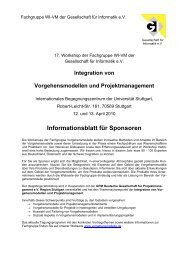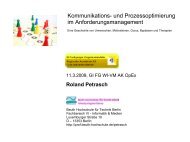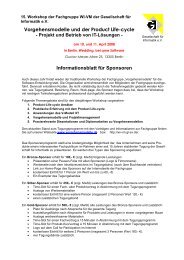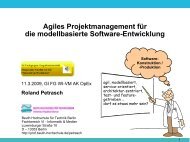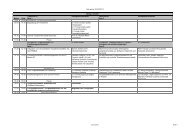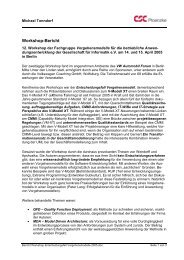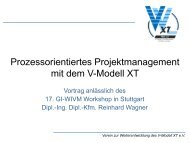Prof Dr Eckhart Hanser Prof. Dr. Eckhart Hanser - der Fachgruppe ...
Prof Dr Eckhart Hanser Prof. Dr. Eckhart Hanser - der Fachgruppe ...
Prof Dr Eckhart Hanser Prof. Dr. Eckhart Hanser - der Fachgruppe ...
You also want an ePaper? Increase the reach of your titles
YUMPU automatically turns print PDFs into web optimized ePapers that Google loves.
<strong>Prof</strong>. <strong>Dr</strong>. <strong>Eckhart</strong> <strong>Hanser</strong>, <strong>Hanser</strong>: DHBW TEAM Lörrach, BUILDING Bio-Systems IN AGILE PROJECTS<br />
Informatics / Software-Engineering<br />
www.dhbw-l<br />
loerrach.de e<br />
TEAM BUILDING IN AGILE SOFTWARE<br />
DEVELOPMENT:<br />
THE “PROJECT MANAGEMENT LABORATORY”<br />
OF BA LOERRACH<br />
<strong>Prof</strong>. <strong>Dr</strong>. <strong>Eckhart</strong> <strong>Hanser</strong><br />
Duale Hochschule Baden-Württemberg Lörrach<br />
Baden-Württemberg Cooperative State University<br />
Head Department Applied Informatics/Bio-Systems Inform.<br />
hanser@dhbw-loerrach.de<br />
<strong>Prof</strong>. <strong>Dr</strong>. <strong>Eckhart</strong> <strong>Hanser</strong>, Duale Hochschule BW Lörrach, BW Cooperative State University, Department of Applied Informatics /Bio-Systems Informatics Folie 1
<strong>Prof</strong>. <strong>Dr</strong>. <strong>Eckhart</strong> <strong>Hanser</strong>: TEAM BUILDING IN AGILE PROJECTS<br />
• Stein Biosystem-Informatik<br />
des Anstoßes:<br />
– Eigene Projekte in <strong>der</strong> Praxis<br />
– För<strong>der</strong>ung des Teambildungsprozess unter<br />
Studierenden an <strong>der</strong> DHBW Lörrach / Bereich<br />
Technik:<br />
• Ziel:<br />
• Informationstechnik (IT)<br />
• Biosystem-Informatik<br />
Vorstellung des<br />
Meta Agile Process Model (MAP)<br />
<strong>Prof</strong>. <strong>Dr</strong>. <strong>Eckhart</strong> <strong>Hanser</strong>, Duale Hochschule BW Lörrach, BW Cooperative State University, Department of Applied Informatics /Bio-Systems Informatics Folie 2
<strong>Prof</strong>. <strong>Dr</strong>. <strong>Eckhart</strong> <strong>Hanser</strong>: TEAM BUILDING IN AGILE PROJECTS<br />
There are Projects with …<br />
• changing specifications<br />
• Refactoring necessary<br />
• Documentation has a short lifetime!<br />
project aim #3<br />
Aim changes! #3<br />
project aim #2<br />
Project start<br />
t<br />
Iter. 3<br />
Iteration 1 Iter. 2<br />
Aim changes! #2<br />
Original project aim<br />
<strong>Prof</strong>. <strong>Dr</strong>. <strong>Eckhart</strong> <strong>Hanser</strong>, Duale Hochschule BW Lörrach, BW Cooperative State University, Department of Applied Informatics /Bio-Systems Informatics Folie 3
<strong>Prof</strong>. <strong>Dr</strong>. <strong>Eckhart</strong> <strong>Hanser</strong>: TEAM BUILDING IN AGILE PROJECTS<br />
Introduction - Agile Manifesto - eXtreme Programming – IT laboratory – Mini team size – Psychology - Conclusions<br />
Agile Manifesto<br />
Kent Beck, Alistair Cockburn, Martin Fowler, Jim Highsmith, Robert C. Martin et.al., 2001<br />
http://www.agilemanifesto.org<br />
Four principles:<br />
• Individuals and interactions over processes and tools<br />
• Working software over comprehensive documentation<br />
• Customer collaboration over contract negotiation<br />
• Responding to change over following a plan<br />
<strong>Prof</strong>. <strong>Dr</strong>. <strong>Eckhart</strong> <strong>Hanser</strong>, Duale Hochschule BW Lörrach, BW Cooperative State University, Department of Applied Informatics /Bio-Systems Informatics Folie 4
<strong>Prof</strong>. <strong>Dr</strong>. <strong>Eckhart</strong> <strong>Hanser</strong>: TEAM BUILDING IN AGILE PROJECTS<br />
Introduction - Agile Manifesto - eXtreme Programming – IT laboratory – Mini team size – Psychology - Conclusions<br />
Famous agile representative: Kent Beck’s<br />
eXtreme Programming g (XP),<br />
Important XP rules to be analyzed:<br />
• Designing User Stories<br />
• Collective Code Ownership and Software Integration<br />
• Pair Programming<br />
<strong>Prof</strong>. <strong>Dr</strong>. <strong>Eckhart</strong> <strong>Hanser</strong>, Duale Hochschule BW Lörrach, BW Cooperative State University, Department of Applied Informatics /Bio-Systems Informatics Folie 5
<strong>Prof</strong>. <strong>Dr</strong>. <strong>Eckhart</strong> <strong>Hanser</strong>: TEAM BUILDING IN AGILE PROJECTS<br />
Introduction - Agile Manifesto - eXtreme Programming – IT laboratory – Mini team size – Psychology - Conclusions<br />
IT laboratory / DHBW Lörrach<br />
2004, 2005, 2006, 2007, 2008<br />
• 6 th semester of Applied Computer Science / Information Technology<br />
• each spring: 11 sessions with 5 (4) hours<br />
=> Up to 800 project hours each spring.<br />
• The size of each course determines the number of the team members<br />
=> Up to 20 team members (students + prof.)<br />
• 2004 – 2008: about 3.500 project hours.<br />
<strong>Prof</strong>. <strong>Dr</strong>. <strong>Eckhart</strong> <strong>Hanser</strong>, Duale Hochschule BW Lörrach, BW Cooperative State University, Department of Applied Informatics /Bio-Systems Informatics Folie 6
<strong>Prof</strong>. <strong>Dr</strong>. <strong>Eckhart</strong> <strong>Hanser</strong>: TEAM BUILDING IN AGILE PROJECTS<br />
Introduction - Agile Manifesto - eXtreme Programming – IT laboratory – Mini team size – Psychology - Conclusions<br />
Project: Development of an eMail marketing software<br />
Test content for the interPM<br />
Hi $Title$ $Name$,<br />
I‘m glad to be here in Düsseldorf.<br />
<strong>Prof</strong>. <strong>Dr</strong>. <strong>Eckhart</strong> <strong>Hanser</strong>, Duale Hochschule BW Lörrach, BW Cooperative State University, Department of Applied Informatics /Bio-Systems Informatics Folie 7
<strong>Prof</strong>. <strong>Dr</strong>. <strong>Eckhart</strong> <strong>Hanser</strong>: TEAM BUILDING IN AGILE PROJECTS<br />
Introduction - Agile Manifesto - eXtreme Programming – IT laboratory – Mini team size – Psychology - Conclusions<br />
IT laboratory of session 2005<br />
BA Loerrach<br />
Prerequisites:<br />
Development<br />
platform:<br />
The lecturer fills the positions of project and quality<br />
manager with suitable “managers” (i.e. students).<br />
In the beginning the rest of the team has no structure,<br />
should however form XP pairs.<br />
Members know about process models, especially XP.<br />
The customer (i.e. the lecturer) is a team member.<br />
MS Visual Studio .NET<br />
Team aims:<br />
Success<br />
Common programming of a “fully featured” email<br />
marketing system.<br />
XP is required (= decision of the lecturer).<br />
Successful product, successful process (in the end).<br />
<strong>Prof</strong>. <strong>Dr</strong>. <strong>Eckhart</strong> <strong>Hanser</strong>, Duale Hochschule BW Lörrach, BW Cooperative State University, Department of Applied Informatics /Bio-Systems Informatics Folie 8
<strong>Prof</strong>. <strong>Dr</strong>. <strong>Eckhart</strong> <strong>Hanser</strong>: TEAM BUILDING IN AGILE PROJECTS<br />
Introduction - Agile Manifesto - eXtreme Programming – IT laboratory – Questions – Psychology - Conclusions<br />
Key questions, I want to investigate:<br />
1. Roles of Project and Quality Manager in agile projects<br />
2. Which (XP) practices are not the result of the „selforganization“<br />
of the team<br />
3. Is there an ideal mini i team size (other than 2) for successful<br />
teams<br />
<strong>Prof</strong>. <strong>Dr</strong>. <strong>Eckhart</strong> <strong>Hanser</strong>, Duale Hochschule BW Lörrach, BW Cooperative State University, Department of Applied Informatics /Bio-Systems Informatics Folie 9
<strong>Prof</strong>. <strong>Dr</strong>. <strong>Eckhart</strong> <strong>Hanser</strong>: TEAM BUILDING IN AGILE PROJECTS<br />
Introduction - Agile Manifesto - eXtreme Programming – IT laboratory – Questions – Psychology - Conclusions<br />
Q1: The project manager in an agile project (i.e. session 2005)<br />
… characterizes his project role as<br />
• coordinator of the project<br />
• problem solver<br />
• communicator<br />
• .NET expert<br />
• co-designer of user stories<br />
(together with the client)<br />
<strong>Prof</strong>. <strong>Dr</strong>. <strong>Eckhart</strong> <strong>Hanser</strong>, Duale Hochschule BW Lörrach, BW Cooperative State University, Department of Applied Informatics /Bio-Systems Informatics Folie 10
<strong>Prof</strong>. <strong>Dr</strong>. <strong>Eckhart</strong> <strong>Hanser</strong>: TEAM BUILDING IN AGILE PROJECTS<br />
Introduction - Agile Manifesto - eXtreme Programming – IT laboratory – Mini team size – Psychology - Conclusions<br />
Q1: The quality manager in an agile project (i.e. session 2005)<br />
… characterizes his project role as<br />
• product and project quality<br />
assurance (reviews, testing) ti • problem solver<br />
• communicator<br />
• .NET expert<br />
• co-designer of user stories<br />
(together th with the client)<br />
Agrees with the view of the project manager!<br />
No classical project roles in this agile project. °<br />
<strong>Prof</strong>. <strong>Dr</strong>. <strong>Eckhart</strong> <strong>Hanser</strong>, Duale Hochschule BW Lörrach, BW Cooperative State University, Department of Applied Informatics /Bio-Systems Informatics Folie 11
<strong>Prof</strong>. <strong>Dr</strong>. <strong>Eckhart</strong> <strong>Hanser</strong>: TEAM BUILDING IN AGILE PROJECTS<br />
Introduction - Agile Manifesto - eXtreme Programming – IT laboratory – Questions – Psychology - Conclusions<br />
Key questions, I want to investigate:<br />
1. Roles of Project and Quality Manager in agile projects<br />
2. Which (XP) practices are not the result of the „selforganization“<br />
of the team<br />
3. Is there an ideal mini i team size (other than 2) for<br />
successful teams<br />
<strong>Prof</strong>. <strong>Dr</strong>. <strong>Eckhart</strong> <strong>Hanser</strong>, Duale Hochschule BW Lörrach, BW Cooperative State University, Department of Applied Informatics /Bio-Systems Informatics Folie 12
<strong>Prof</strong>. <strong>Dr</strong>. <strong>Eckhart</strong> <strong>Hanser</strong>: TEAM BUILDING IN AGILE PROJECTS<br />
Introduction - Agile Manifesto - eXtreme Programming – IT laboratory – Questions – Psychology - Conclusions<br />
Q2: Design of user stories<br />
• In every session only project manager, quality manager and few team<br />
members where interested in creating user stories.<br />
• Only when the mini teams had chosen their story cards, they began actively<br />
to make a detailed low level design.<br />
• We saw no readiness in the team for collective design or code ownership.<br />
No collective code ownership<br />
<strong>Prof</strong>. <strong>Dr</strong>. <strong>Eckhart</strong> <strong>Hanser</strong>, Duale Hochschule BW Lörrach, BW Cooperative State University, Department of Applied Informatics /Bio-Systems Informatics Folie 13
<strong>Prof</strong>. <strong>Dr</strong>. <strong>Eckhart</strong> <strong>Hanser</strong>: TEAM BUILDING IN AGILE PROJECTS<br />
Introduction - Agile Manifesto - eXtreme Programming – IT laboratory – Questions – Psychology - Conclusions<br />
Q2: Integration XP says: „Only a pair integrates code at a time.“<br />
But our experience in all sessions:<br />
• Integration is not a result of the „self-organization“ of the team (> 3 programmers).<br />
• 2004 – 2008 integration only took place after heavy interventions of the customer.<br />
• The lecturer had to take over the role of a communicator – not of a typical customer!<br />
not to solve the problem, but to communicate its existence.<br />
• Integration had to be „centralized“.<br />
Not only one machine but also one team member (with full responsibility)<br />
• New role: Integration Engineer<br />
• This has to be controlled strictly by the project management.<br />
=> We need a project management!<br />
<strong>Prof</strong>. <strong>Dr</strong>. <strong>Eckhart</strong> <strong>Hanser</strong>, Duale Hochschule BW Lörrach, BW Cooperative State University, Department of Applied Informatics /Bio-Systems Informatics Folie 14
<strong>Prof</strong>. <strong>Dr</strong>. <strong>Eckhart</strong> <strong>Hanser</strong>: TEAM BUILDING IN AGILE PROJECTS<br />
Introduction - Agile Manifesto - eXtreme Programming – IT laboratory – Mini team size – Psychology - Conclusions<br />
A new team role: Integration Engineer<br />
sits a little “aside“<br />
…<br />
“Lone Wolf”<br />
session 2005<br />
<strong>Prof</strong>. <strong>Dr</strong>. <strong>Eckhart</strong> <strong>Hanser</strong>, Duale Hochschule BW Lörrach, BW Cooperative State University, Department of Applied Informatics /Bio-Systems Informatics Folie 15
<strong>Prof</strong>. <strong>Dr</strong>. <strong>Eckhart</strong> <strong>Hanser</strong>: TEAM BUILDING IN AGILE PROJECTS<br />
Introduction - Agile Manifesto - eXtreme Programming – IT laboratory – Questions – Psychology - Conclusions<br />
Key questions, I want to investigate:<br />
1. Roles of Project and Quality Manager in agile projects<br />
2. Which (XP) practices are not the result of the „selforganization“<br />
of the team<br />
3. Practical experience shows that t teams with more as about 5 members<br />
subdivide into „mini teams“:<br />
1. In XP such a mini team is called a „pair“ (2 members).<br />
Are these pairs successful<br />
2. Is there an ideal mini team size (other than 2)<br />
3. Do we see a self-organization process of successful mini<br />
teams<br />
4. What is the member structure<br />
<strong>Prof</strong>. <strong>Dr</strong>. <strong>Eckhart</strong> <strong>Hanser</strong>, Duale Hochschule BW Lörrach, BW Cooperative State University, Department of Applied Informatics /Bio-Systems Informatics Folie 16
<strong>Prof</strong>. <strong>Dr</strong>. <strong>Eckhart</strong> <strong>Hanser</strong>: TEAM BUILDING IN AGILE PROJECTS<br />
Introduction - Agile Manifesto - eXtreme Programming – IT laboratory – Mini team size – Psychology - Conclusions<br />
Q3: Mini i team size<br />
session 2004 session 2005 - 2008<br />
Mini teams with 3 members as<br />
“starting point”.<br />
Result: XP pairs do not occur.<br />
XP pairs as initial mini teams.<br />
Minimal mini team size remains 3.<br />
The most successful mini team has 4<br />
members.<br />
<strong>Prof</strong>. <strong>Dr</strong>. <strong>Eckhart</strong> <strong>Hanser</strong>, Duale Hochschule BW Lörrach, BW Cooperative State University, Department of Applied Informatics /Bio-Systems Informatics Folie 17
<strong>Prof</strong>. <strong>Dr</strong>. <strong>Eckhart</strong> <strong>Hanser</strong>: TEAM BUILDING IN AGILE PROJECTS<br />
Introduction - Agile Manifesto - eXtreme Programming – IT laboratory – Mini team size – Psychology - Conclusions<br />
Project<br />
start<br />
Q3: Mini i team size<br />
We see<br />
3 pairs<br />
…<br />
A triplet<br />
First pair grows<br />
into a triplet!<br />
session 2005<br />
<strong>Prof</strong>. <strong>Dr</strong>. <strong>Eckhart</strong> <strong>Hanser</strong>, Duale Hochschule BW Lörrach, BW Cooperative State University, Department of Applied Informatics /Bio-Systems Informatics Folie 18
<strong>Prof</strong>. <strong>Dr</strong>. <strong>Eckhart</strong> <strong>Hanser</strong>: TEAM BUILDING IN AGILE PROJECTS<br />
Introduction - Agile Manifesto - eXtreme Programming – IT laboratory – Mini team size – Psychology - Conclusions<br />
2 weeks<br />
later<br />
But also one<br />
Super<br />
team<br />
with<br />
6 members<br />
for<br />
integration<br />
ti<br />
session 2005<br />
<strong>Prof</strong>. <strong>Dr</strong>. <strong>Eckhart</strong> <strong>Hanser</strong>, Duale Hochschule BW Lörrach, BW Cooperative State University, Department of Applied Informatics /Bio-Systems Informatics Folie 19
<strong>Prof</strong>. <strong>Dr</strong>. <strong>Eckhart</strong> <strong>Hanser</strong>: TEAM BUILDING IN AGILE PROJECTS<br />
Introduction - Agile Manifesto - eXtreme Programming – IT laboratory – Mini team size – Psychology - Conclusions<br />
4 weeks<br />
later<br />
Only 1<br />
"classical“<br />
XP pair<br />
XP pairs<br />
decrease!<br />
session 2005<br />
<strong>Prof</strong>. <strong>Dr</strong>. <strong>Eckhart</strong> <strong>Hanser</strong>, Duale Hochschule BW Lörrach, BW Cooperative State University, Department of Applied Informatics /Bio-Systems Informatics Folie 20
<strong>Prof</strong>. <strong>Dr</strong>. <strong>Eckhart</strong> <strong>Hanser</strong>: TEAM BUILDING IN AGILE PROJECTS<br />
Introduction - Agile Manifesto - eXtreme Programming – IT laboratory – Mini team size – Psychology - Conclusions<br />
Mini Team Size<br />
session 2004 session 2005 Session 2008<br />
Mini teams with 3<br />
XP pairs as initial mini<br />
XP pairs as initial mini<br />
members as “starting teams.<br />
teams.<br />
point”.<br />
Result: XP pairs do not<br />
Result: Number of XP<br />
Result: 3 XP pairs<br />
occur.<br />
pairs seems to decrease. “survive”.<br />
Minimal mini team size Most mini teams grow in 50% of the team are XP<br />
remains 3. size (3, 4 or more). pairs!<br />
The most successful mini<br />
team has 4 members.<br />
In special phases, e.g.<br />
integration, we see a<br />
team size of 6 members.<br />
Integration: several pairs<br />
form a larger integration<br />
team.<br />
Mini team size “oscillates”<br />
depending on the phase/activity.<br />
<strong>Prof</strong>. <strong>Dr</strong>. <strong>Eckhart</strong> <strong>Hanser</strong>, Duale Hochschule BW Lörrach, BW Cooperative State University, Department of Applied Informatics /Bio-Systems Informatics Folie 21
<strong>Prof</strong>. <strong>Dr</strong>. <strong>Eckhart</strong> <strong>Hanser</strong>: TEAM BUILDING IN AGILE PROJECTS<br />
Introduction - Agile Manifesto - eXtreme Programming – IT laboratory – Mini team size – Psychology - Conclusions<br />
Inter XP pair relations (2008)<br />
<strong>Prof</strong>. <strong>Dr</strong>. <strong>Eckhart</strong> <strong>Hanser</strong>, Duale Hochschule BW Lörrach, BW Cooperative State University, Department of Applied Informatics /Bio-Systems Informatics Folie 22
<strong>Prof</strong>. <strong>Dr</strong>. <strong>Eckhart</strong> <strong>Hanser</strong>: TEAM BUILDING IN AGILE PROJECTS<br />
Introduction - Agile Manifesto - eXtreme Programming – IT laboratory – Mini team size – Psychology - Conclusions<br />
“Super team” explained:<br />
• 5 members<br />
• Integrates the code in a critical<br />
phase.<br />
• The members take responsibility<br />
for the integration.<br />
• The project would fail, if they did<br />
not succeed.<br />
Integration Engineer<br />
session 2005<br />
<strong>Prof</strong>. <strong>Dr</strong>. <strong>Eckhart</strong> <strong>Hanser</strong>, Duale Hochschule BW Lörrach, BW Cooperative State University, Department of Applied Informatics /Bio-Systems Informatics Folie 23
<strong>Prof</strong>. <strong>Dr</strong>. <strong>Eckhart</strong> <strong>Hanser</strong>: TEAM BUILDING IN AGILE PROJECTS<br />
Introduction - Agile Manifesto - eXtreme Programming – IT laboratory – Mini team size – Psychology - Conclusions<br />
Organizational psychology:<br />
discussed with Rainer Baldegger, „Erfolgreich im Team“<br />
<strong>Prof</strong>. <strong>Dr</strong>. <strong>Eckhart</strong> <strong>Hanser</strong>, Duale Hochschule BW Lörrach, BW Cooperative State University, Department of Applied Informatics /Bio-Systems Informatics Folie 24
<strong>Prof</strong>. <strong>Dr</strong>. <strong>Eckhart</strong> <strong>Hanser</strong>: TEAM BUILDING IN AGILE PROJECTS<br />
Introduction - Agile Manifesto - eXtreme Programming – IT laboratory – Mini team size – Psychology - Conclusions<br />
A successfull Mini Team needs particularly<br />
• Creative Mind<br />
• Technical Expert<br />
• Team Worker<br />
• Communicator<br />
• Technical Problem Solver<br />
• Quality Tester<br />
<strong>Prof</strong>. <strong>Dr</strong>. <strong>Eckhart</strong> <strong>Hanser</strong>, Duale Hochschule BW Lörrach, BW Cooperative State University, Department of Applied Informatics /Bio-Systems Informatics Folie 25
<strong>Prof</strong>. <strong>Dr</strong>. <strong>Eckhart</strong> <strong>Hanser</strong>: TEAM BUILDING IN AGILE PROJECTS<br />
Introduction - Agile Manifesto - eXtreme Programming – IT laboratory – Mini team size – Psychology - Conclusions<br />
Details of the “super team“<br />
Project Manager<br />
“external“<br />
Communicator<br />
(Project<br />
manager)<br />
Problem solver / integrator<br />
“Lone wolf“<br />
Expert,<br />
creative<br />
mind<br />
Integration Engineer<br />
Team<br />
worker<br />
Team<br />
worker<br />
“internal“<br />
communicator,<br />
creative mind<br />
Expert,<br />
creative<br />
mind<br />
session 2005<br />
Quality tester<br />
Quality Manager<br />
<strong>Prof</strong>. <strong>Dr</strong>. <strong>Eckhart</strong> <strong>Hanser</strong>, Duale Hochschule BW Lörrach, BW Cooperative State University, Department of Applied Informatics /Bio-Systems Informatics Folie 26
<strong>Prof</strong>. <strong>Dr</strong>. <strong>Eckhart</strong> <strong>Hanser</strong>: TEAM BUILDING IN AGILE PROJECTS<br />
Introduction - Agile Manifesto - eXtreme Programming – IT laboratory – Mini team size – Psychology – Actual results<br />
IT-Labor 2007<br />
– Prozess Crystal Clear<br />
Bewertung des Prozess durch das Team / Umfrageergebnis:<br />
Schulnoten!<br />
Wissenschaftliche<br />
Begleitung:<br />
aus Studienarbeit<br />
Niko Hättich 2007<br />
<strong>Prof</strong>. <strong>Dr</strong>. <strong>Eckhart</strong> <strong>Hanser</strong>, Duale Hochschule BW Lörrach, BW Cooperative State University, Department of Applied Informatics /Bio-Systems Informatics Folie 27
<strong>Prof</strong>. <strong>Dr</strong>. <strong>Eckhart</strong> <strong>Hanser</strong>: TEAM BUILDING IN AGILE PROJECTS<br />
Introduction - Agile Manifesto - eXtreme Programming – IT laboratory – Mini team size – Psychology – Actual results<br />
Crystal Clear 2007<br />
(1) Note nur für interne Osmotische Kommunikation<br />
nachvollziehbar<br />
(2) Reflektion nicht festgestellt.<br />
(3) Lieferungen unregelmäßig.<br />
2007: Team „fährt fährt“ seinen eigenen agilen Prozess!<br />
<strong>Prof</strong>. <strong>Dr</strong>. <strong>Eckhart</strong> <strong>Hanser</strong>, Duale Hochschule BW Lörrach, BW Cooperative State University, Department of Applied Informatics /Bio-Systems Informatics Folie 28
<strong>Prof</strong>. <strong>Dr</strong>. <strong>Eckhart</strong> <strong>Hanser</strong>: TEAM BUILDING IN AGILE PROJECTS<br />
Introduction - Agile Manifesto - eXtreme Programming – IT laboratory – Mini team size – Psychology - Conclusions<br />
„Meta Agile Process Model“ (MAP Methodology)<br />
A successful project in a small to medium-sized team needs the following “ingredients“:<br />
• Customer<br />
• available to the team<br />
• One or two Communication managers, good and flexible<br />
• for project and quality management<br />
• Integration engineer<br />
• continuous software integration<br />
• Well-balanced project team with a good psychological process<br />
• 6 characters / types of project members (organizational psychology)<br />
Mini-Team-Size is „oscillating“!<br />
<strong>Prof</strong>. <strong>Dr</strong>. <strong>Eckhart</strong> <strong>Hanser</strong>, Duale Hochschule BW Lörrach, BW Cooperative State University, Department of Applied Informatics /Bio-Systems Informatics Folie 29
<strong>Prof</strong>. <strong>Dr</strong>. <strong>Eckhart</strong> <strong>Hanser</strong>: TEAM BUILDING IN AGILE PROJECTS<br />
MAP Referenzprojekt aus<br />
<strong>der</strong> Chemie-Industrie:<br />
Sep. 2008:<br />
• Erfolgreiche Diplomarbeit<br />
als „Feldversuch“ zur agilen<br />
Methodology MAP<br />
• Laborergebnisse werden im<br />
Wesentlichen bestätigt!<br />
<strong>Prof</strong>. <strong>Dr</strong>. <strong>Eckhart</strong> <strong>Hanser</strong>, Duale Hochschule BW Lörrach, BW Cooperative State University, Department of Applied Informatics /Bio-Systems Informatics Folie 30
<strong>Prof</strong>. <strong>Dr</strong>. <strong>Eckhart</strong> <strong>Hanser</strong>: TEAM BUILDING IN AGILE PROJECTS<br />
Rollen:<br />
• Kunde<br />
„Rotes Telefon“<br />
• Projektleiter 1<br />
• Qualitätsmanager 1<br />
1Person<br />
• Entwickler 5 (im Schnitt 3)<br />
• Integrierer<br />
• Tester 1<br />
1 (hier = PL)<br />
<strong>Prof</strong>. <strong>Dr</strong>. <strong>Eckhart</strong> <strong>Hanser</strong>, Duale Hochschule BW Lörrach, BW Cooperative State University, Department of Applied Informatics /Bio-Systems Informatics Folie 31
<strong>Prof</strong>. <strong>Dr</strong>. <strong>Eckhart</strong> <strong>Hanser</strong>: TEAM BUILDING IN AGILE PROJECTS<br />
Probleme mit Pair Programming<br />
bestätigt:<br />
• Voraussetzung: Sozialkompetenz<br />
• Problem: Effizienz<br />
• PP im Team als nicht notwendig erachtet!<br />
• Truck-Faktor durch Kommunikation reduziert.<br />
<strong>Prof</strong>. <strong>Dr</strong>. <strong>Eckhart</strong> <strong>Hanser</strong>, Duale Hochschule BW Lörrach, BW Cooperative State University, Department of Applied Informatics /Bio-Systems Informatics Folie 32
<strong>Prof</strong>. <strong>Dr</strong>. <strong>Eckhart</strong> <strong>Hanser</strong>: TEAM BUILDING IN AGILE PROJECTS<br />
Allg. Projekt mit IT-Fokus (Okt. 2008):<br />
LKW-Abfertigung in einer Ölraffinerie<br />
• Highlight: Impl. eines Zugangskontrollsystems<br />
• Der Kunde kommt aus dem operativen Betreiber-Bereich<br />
mit starken DV-Kenntnissen<br />
• Projektleiter kommt aus <strong>der</strong> Projektabteilung für Neubau-<br />
Projekte (eigene Anlagenbauprojekte bis 15 M€ pro Proj.)<br />
• hohe Schnittstellen zu vom Projekt Betroffenen, Beteiligten<br />
und Interessierten; vor allem zu den Gewerken Tiefbau,<br />
Elektrik und Mess- und Regeltechnik<br />
• MAP wird bestätigt!<br />
– siehe auch GPM-Newsletter<br />
<strong>Prof</strong>. <strong>Dr</strong>. <strong>Eckhart</strong> <strong>Hanser</strong>, Duale Hochschule BW Lörrach, BW Cooperative State University, Department of Applied Informatics /Bio-Systems Informatics Folie 33




